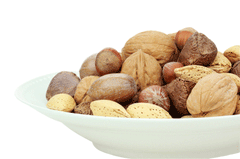Chickpeas in gravy
Looking for a way to add plant-based protein to your diet? Here is an excellent recipe. I found this recipe on my Tweeter feed this morning and thought it looked like something we should try. It's best to soak dried beans and cook them rather than using canned, but I know it seems easier to just open a can. I even tried soaking them and using them "raw", but seriously they get rancid/moldy much too quickly unless you keep a close eye on them. Check out the blog, Quantum Vegan, for the full article and recipe. She mentions adding flour to thicken the gravy. The way we like our gravy is cashew gravy and we just put the raw (preferably soaked but I usually don't remember to do this) nuts and water in the blender (Vitamix is great, but we don't have one) and add one tablespoon of whatever flour you want - actually garbanzo bean flour would work. We're always looking for substitutes for refined flours and wheat while also trying to eliminate as many sources of gluten from our diet as possible. Let me just say that I haven't tried this recipe yet, but will probably fix it for Warren tonight. However, I have definitely discovered that after many years of eating regular flour/roux type gravy, I much prefer the cashew gravy. I like to add about a tablespoon of veggie chicken broth seasoning (msg free!) or other seasoning depending on what flavor I'm trying to achieve. Since this recipe highlights thyme, I would think "chicken" broth would be great and we prefer the veggie type. I know, I know veggie chicken is an oxymoron! Try it like she has it or adjust it with the cashew gravy - either way, it sounds like a keeper.
Ingredients
1/2 tbsp olive oil
1/2 cup onion, chopped small
2 garlic cloves, minced
2 tbsp flour
1tsp dried thyme
1-2cups veg broth
1 15.5oz can chickpeas, drained & rinsed
salt & pepper to taste
Directions
1) In a large skillet or saute pan, heat oil over
medium heat. Add the onions and garlic, cover and cook until softened,
about 5 minutes.
2) Add the flour and cook, stirring, until browned, 2-5 minutes. Add the thyme, chickpeas, and 1 cup of broth; stir well to combine.
3) Bring the mixture a boil, reduce heat to medium-low and simmer for 10-15 minutes to thicken. Add more broth as necessary if the gravy becomes too thick. Season to taste with salt & pepper. Serve hot.
What so great about cashews?:
The great thing about this recipe, especially if you substitute the regular gravy which has very little nutritional value, is to use the cashew gravy. Did you know that cashews (contrary to what I was taught years ago), have a lower fat content than most other nuts, approximately 75% of their fat is unsaturated fatty acids, plus about 75% of this unsaturated fatty acid content is oleic acid, the same heart-healthy monounsaturated fat found in olive oil! They are high in antioxidants as well. Now how much protein? Cashews have about 17 grams of protein for each 100 grams of nuts (about 3.5 ounces.) Check here for information from Whole Foods about all the healthy benefits you get from adding nuts, such as cashew nuts, into your diet.
What about chickpeas?:
Chickpeas (garbanzo beans) are best known for their very high protein and fiber content. One of my favorite ways to use chickpeas in to make hummus dip for celery. For those of us trying to increase our plant-based protein and fiber in our meal plans - chickpeas are one of your best bets. For just one cup of beans you will get approximately 17 grams of protein! That's a lot! And as well as that you will receive about 14 grams of fiber. This particular bean has been studied and has shown that incorporating chickpeas into your diet will help keep you satisfied without food cravings. For more information about chickpeas, here is the link to Whole Foods detailed information.
Let me know if you try it!


































